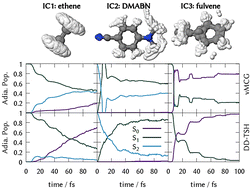Benchmarking non-adiabatic quantum dynamics using the molecular Tully models†
Abstract
On-the-fly non-adiabatic dynamics methods are becoming more important as tools to characterise the time evolution of a system after absorbing light. These methods, which calculate quantities such as state energies, gradients and interstate couplings at every time step, circumvent the requirement for pre-computed potential energy surfaces. There are a number of different algorithms used, the most common being Tully Surface Hopping (TSH), but all are approximate solutions to the time-dependent Schrödinger equation and benchmarking is required to understand their accuracy and performance. For this, a common set of systems and observables are required to compare them. In this work, we validate the on-the-fly direct dynamics variational multi-configuration Gaussian (DD-vMCG) method using three molecular systems recently suggested by Ibele and Curchod as molecular versions of the Tully model systems used to test one-dimensional non-adiabatic behaviour [Ibele et al., Phys. Chem. Chem. Phys. 2020, 22, 15183–15196]. Parametrised linear vibronic potential energy surfaces for each of the systems were also tested and compared to on-the-fly results. The molecules, which we term the Ibele–Curchod models, are ethene, DMABN and fulvene and the authors used them to test and compare several versions of the Ab Initio Multiple Spawning (AIMS) method alongside TSH. The three systems present different deactivation pathways after excitation to their ππ* bright states. When comparing DD-vMCG to AIMS and TSH, we obtain crucial differences in some cases, for which an explanation is provided by the classical nature and the chosen initial conditions of the TSH simulations.

- This article is part of the themed collections: Celebrating International Women’s day 2025: Women in physical chemistry, Molecular Dynamics in the Gas Phase and 2023 PCCP HOT Articles


 Please wait while we load your content...
Please wait while we load your content...